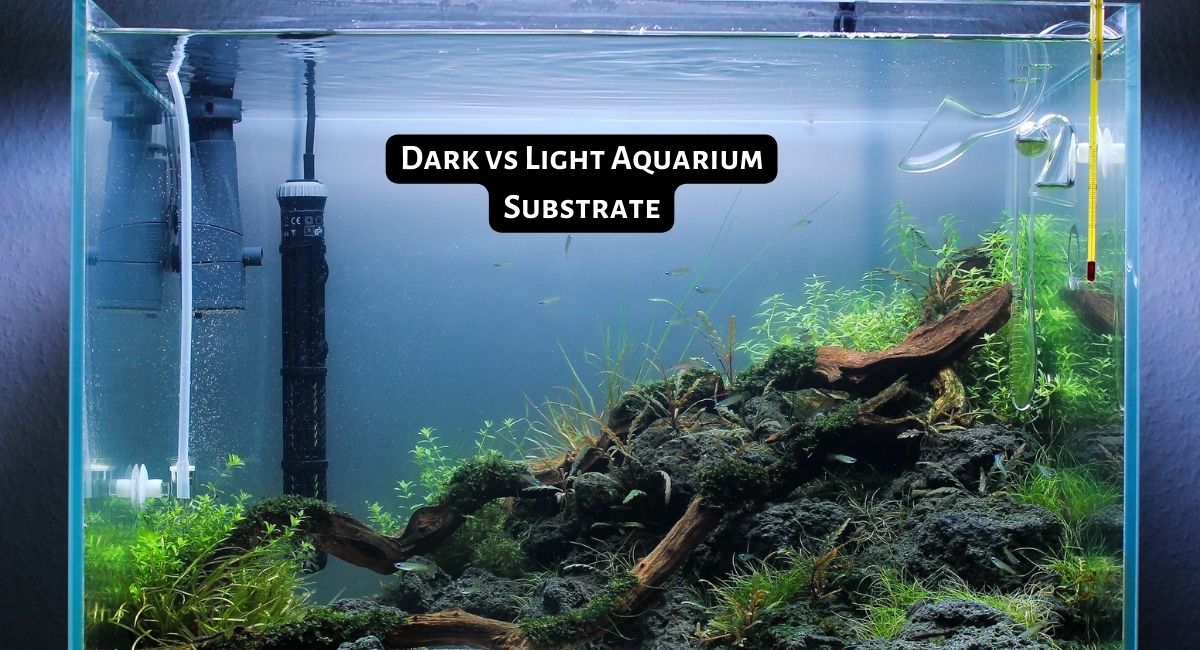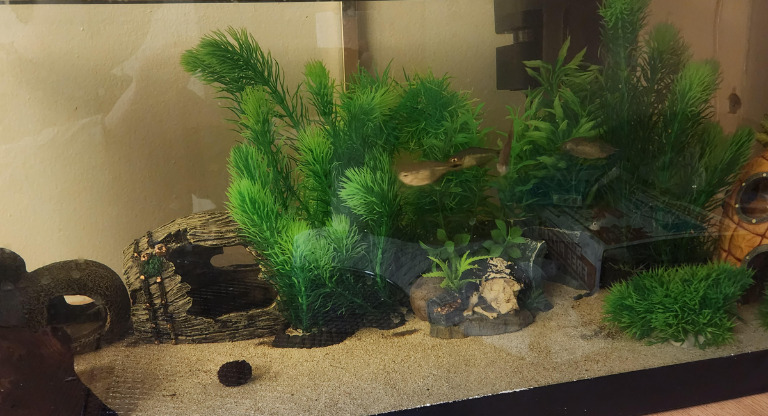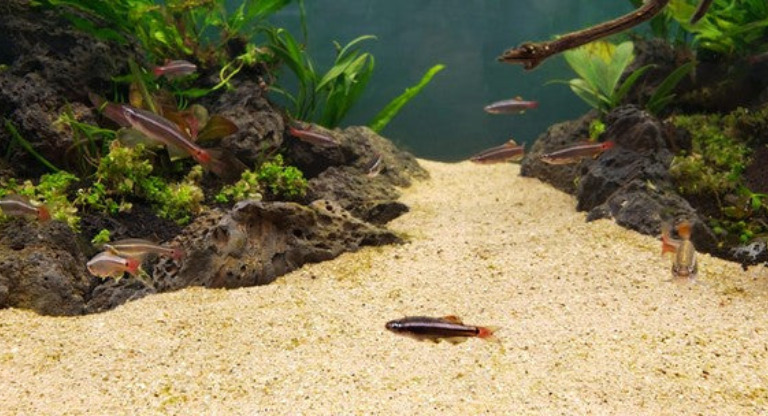Smartplantedaquarium.com participates in affiliate marketing programs. We may earn commissions on purchases made through our affiliate links. This doesn't affect our content or recommendations and we only recommend products we would put in our own tanks.
As an expert in planted aquariums, I know just how important the right kind of substrate is for your aquatic environment. and light substrates may look, but actually have vastly different effects on the overall health of your plants. In this blog post, I’m going to dive into the differences between dark vs light aquarium substrate so you can make informed decisions about which one is best for your tank. We’ll compare their chemical properties, effects on plant growth, and more – so read on to learn all about dark vs light aquarium substrate!
TL;DR
The choice between dark or light aquarium substrate ultimately depends on your particular tank setup and preferences, however dark substrate absorbs more heat than light substrate and can cause higher water temperatures in the tank while light substrate allows for more plant growth but is more prone to algae growth due to increased light intensity. Consider both pros and cons before making a decision.
Contents
Dark vs Light Aquarium Substrate
If you’re into planted aquariums, chances are you’ve heard of dark vs light aquarium substrates. Dark substrate offers a darker, more natural look which many hobbyists prefer. While it has its advantages, it also comes with some drawbacks that should be considered before making a decision about your tank’s bottom layer. This article will explore the pros and cons of both dark and light aquarium substrates so that you can make an informed decision for your setup.
What is Aquarium Substrate?
Aquarium substrate is the material used to cover the bottom of an aquarium. It is necessary for fish and other aquatic creatures to live comfortably in their environment. The type and size of substrate chosen affects the health of your aquarium, as well as its appearance.
Substrate is super essential for the well-being and continuation of your aquarium. So give it proper thought.
When deciding on what kind of substrate to use, there are two main types to consider: dark or light. There are a few things you should think about before choosing either option.
Why is substrate necessary you ask? Read on.
Do you need Aquarium Substrate?
There are two main types of aquarium substrates to choose from: dark and light. Each type has its own advantages and disadvantages, so it is important to understand the differences before making a decision.
When considering dark vs light aquarium substrate, the most important factor to consider is the type of fish that will be kept in the tank. Darker substrates can give an overall darker look to the aquarium, which can be beneficial for some fish species that prefer lower lighting levels or need more hiding places. On the other hand, lighter colored substrates can provide better visibility of plants and decorations in tanks with higher lighting levels.
Types of Aquarium Substrate
When considering Dark vs Light Aquarium Substrate, it’s important to understand the different types of aquarium substrate available. Generally, there are two main categories: those designed for live plants and those designed for fish-only tanks.
For live plant aquariums, a variety of substrates can be used including sand, gravel, soil, clay pellets and crushed coral. Sand is often preferred as it offers a natural appearance and allows roots to more easily penetrate the substrate. Gravel serves as an aesthetically pleasing alternative but can also be difficult for root penetration due to its compactness. Soil substrates typically contain nutrients which help promote plant growth while clay pellets provide excellent aeration and water filtration benefits when used with a quality filter. Finally, crushed coral is often used in saltwater aquariums as the substrate’s slightly alkaline nature helps to maintain water chemistry stability.
For fish-only tanks, there are several types of substrates available including gravel and sand. Gravel typically provides better filtration than sand due to its larger size but it can be more difficult for fish to clean and can also trap debris which can cause an unhealthy environment. Sand offers more natural looking appearance but needs to be vacuumed regularly to avoid excessive waste buildup which could lead to health problems for fish living in the tank.
What is Dark Aquarium Substrate?
Dark aquarium substrate is made up of materials such as black and gray gravel, sand, and other dark-colored rocks that provide a darker color to the bottom of the tank. Many people opt for a darker substrate because it can make colors in the fish tanks appear more vivid and vibrant. Furthermore, using a dark substrate helps create a bold contrast between decorations or plants in an aquarium, making them stand out more. This type of substrate also helps reduce light reflection from any source coming into the tank, creating an ambient atmosphere for both fish and other aquatic inhabitants.
Additionally, dark substrates are ideal for planted tanks since they allow for better absorption of sunlight by plant roots thus encouraging plant growth. They provide essential nutrients like iron which allows for the of healthy plants. Finally, dark substrate can provide a sense of for some aquatic creatures since most habitats have darker substrates and may be more comfortable for them to live in a similar environment.
Dark Aquarium Substrate can provide a more natural look to your aquarium and it will bring out the colors of your fish better than lighter substrates do. Darker substrates also absorb more heat which can be beneficial in keeping water temperatures stable and warm enough for tropical fish. On the downside, dark substrate can lead to an accumulation of detritus which could lead to more frequent water changes and cleaning. It may also cause algae growth because it is not reflective of light.
What is Light Aquarium Substrate?
Light aquarium substrate is composed of materials such as white and tan gravel, sand, and other light-colored rocks that provide a lighter color to the bottom of the tank. This type of substrate helps create a brighter atmosphere and can make smaller details like decorations or plants stand out more. Furthermore, using a light substrate helps reduce any surface glare from lights coming into the tank while also helping to illuminate certain areas within an aquarium that may otherwise be too dimly lit by traditional lighting setups.
Light substrates are ideal for tanks with bright fish and plants as they can help show off the vivid colors of each much better than darker substrates. Additionally, light substrate helps create a more natural-looking environment in an aquarium since most aquatic habitats have lighter colored substrates. Finally, using a light substrate may also provide some comfort to certain inhabitants of the tank as it could resemble their natural habitat more closely.
Light Aquarium Substrate provides a brighter and more vibrant atmosphere in your aquarium and the lighter color reflects better off the walls making it easier for you to spot things like dirt or debris. Light substrates are less likely to accumulate detritus than darker substrates, making water changes simpler. The one drawback is that they don’t absorb heat as well as darker substrates do so you may need to use a heating source if you plan on keeping tropical fish in your tank.
Comparing Light and Dark Aquarium Substrates
When considering the appearance of your aquarium, one factor you should pay particular attention to is the type substrate used. The two main options are dark and light aquarium substrates. Choosing between the two can be difficult since both have their advantages and disadvantages.
Light aquarium substrates come in a variety of colors ranging from white or cream to yellow or tan, depending on what type you choose. These lighter shades make it easier for plants to absorb sunlight, which helps them thrive in an aquarium setting. Light substrates also show off any decorations that you put in your tank more clearly than darker varieties do as they don’t reflect back colors as strongly into the water. On the downside, many fishes prefer darker colors when it comes to substrate in order to feel more secure, so if you have a fish that likes the shade, this may not be the best option for them.
Dark aquarium substrates are usually shades of brown or black and can give your tank an interesting, natural look. Darker colors also tend to make plants look greener as they contrast with the substrate color. Fish also generally prefer darker colors as it helps them feel safer in their environment. The downside is that a dark substrate makes decorations harder to spot which can detract from the overall appearance of your tank. Additionally, dark colors absorb more sunlight meaning there’s less light available for plant growth and photosynthesis.
What Color Substrate Should You Choose?
When it comes to creating an eye-catching aquarium, the choice of substrate is a critical factor. With a wide range of color options available, deciding between dark and light substrates can be difficult. Both have their advantages and disadvantages that should be taken consideration before making a decision.
Dark substrates are ideal for bringing out the vibrant colors in tropical fish. These darker colored amplifies the colors of your aquatic life, as well as giving off more intense reflections when illuminating with lighting equipment. Darker substrates also serve as camouflage for shy fish or those trying to hide from predators. However, they tend to make tank maintenance more challenging since algae growth tends to be higher in darker tanks due to increased light absorption.
Light-colored substrates are great for allowing maximum light penetration into the tank and helping to reduce algae growth. They also create a softer, natural look when combined with lighter colored decorations and rocks. One downside of light substrate is that it has a tendency to wash out the colors of your fish, creating an anonymous environment.
No matter what color you choose, be sure to use one that won’t alter pH levels or release any chemicals into the water. Aquarium gravel is safe because it’s inert and doesn’t affect water quality in any way but if you plan on using sand or other substrates, make sure they are aquarium safe before adding them to the tank.
Conclusion
In conclusion, choosing the right aquarium substrate for your fish tank is a matter of personal preference but also depends on the type of plants you intend to keep and the type of fish or other aquatic life you plan to introduce. There are pros and cons to both dark and light substrates; it mostly comes down to whether you want an aesthetically pleasing setup with vibrant colors in your tank or if you’re looking for a background that won’t distract from the aquascape.
Dark substrates can provide nutrient-rich environments for aquatic life, while light substrates allow rooted plants more access to sunlight. Ultimately, it’s important to find a balance between aesthetics and practicality when selecting the best aquarium substrate for your needs. With careful consideration, both dark and light substrates can create beautiful aquariums that are sure to make a lasting impression.
Frequently Asked Questions (FAQs)
1. Should aquarium substrate be light or dark?
It depends on the types of plants and fish in your aquarium. Generally, dark substrates are best for fish that like to hide and blend into their surroundings. They also help bring out the colors of some species, such as neon tetras or angelfish. Light substrates can be beneficial for live plants because they produce a more natural-looking environment. Ultimately, it is up to you to decide which type of substrate will work best for your aquarium setup. Consider the needs of all its inhabitants when making your decision!
2. What color aquarium gravel is best?
The best color aquarium gravel to use depends on the type of aquatic life you plan to keep in your tank. Generally, dark-colored aquarium substrates will provide a more natural look and better blend with plants and decorations while also creating a striking contrast against brightly colored fish. On the other hand, light-colored gravels allow light to reflect off the bottom of the tank and highlight background decorations, as well as providing a good contrast for pale or transparent fish. Ultimately, it is up to personal preference when choosing an aquarium substrate color.
3. Does substrate affect fish color?
Yes, substrate can affect the color of fish. Fish living in darker substrates may tend to show their natural colors more intensely and brighter than those kept in lighter ones. This is because darker substrates create contrast with the body coloration of the fish, making them stand out more and appear brighter. Lighter colored substrates on the other hand may wash out some of a fish’s pigment due to lack of contrast. Additionally, dark substrates absorb light better, so they can help create a cooler environment for your fish which often results in greater color vibrancy. It also provides relief from bright aquarium lighting that can cause stress or alter the actual pigmentation of certain species.






